type
status
slug
summary
tags
category
icon
password
ID
date
Author
URL
In the 2019 Single’s Day (China’s online version of Black Friday) sales ranking, a brand called “Genki Forest” beat Coca-Cola and Pepsi to rank second in beverage category.
Genki Forest(Yuanqi Senlin), a Chinese beverage company disguised as a Japanese brand, has grown rapidly into a large beverage company valued at 4 billion in the past three years. What made Genki Forest successful was not its brand strategy, which disguised itself as a Japanese brand, but the products it launched after delving into the Chinese youth market.
As we all know, the beverage market is more and more affected by the concept of health, people do not want to destroy the body for a while. Beverage manufacturers in the past have always been unable to strike a perfect balance between health and taste, and Genki Forest has seized this to make innovative products.
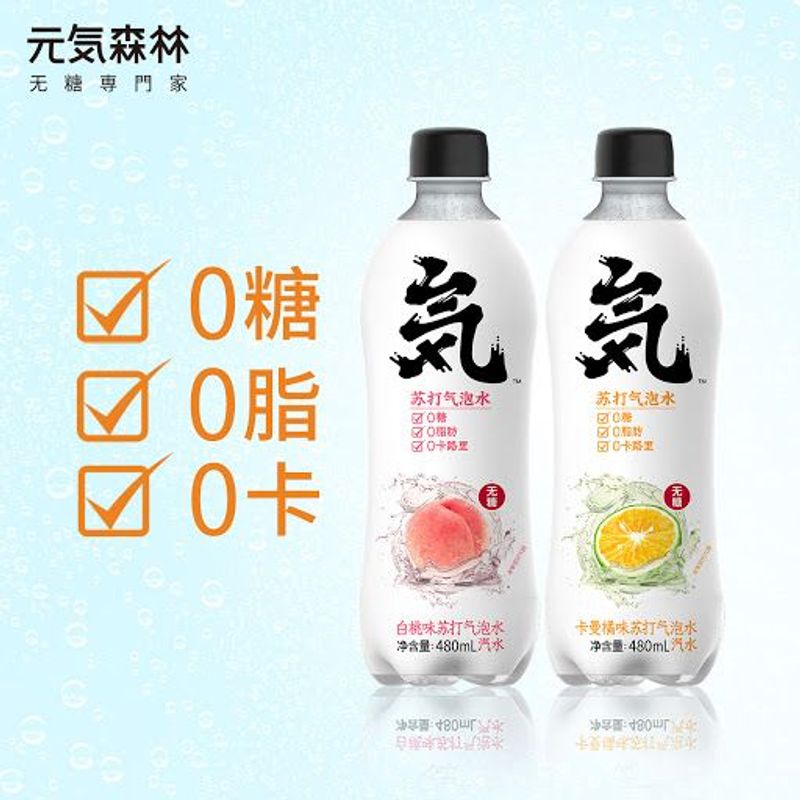
Genki Forest
Genki Forest has two more popular product lines, one of which is the Genki Forest series named after the company, which is positioned as fruity sparkling water. Unlike other sodas on the market, Genki Forest Series, although fruity drinks, innovatively removes sugar from drinks and makes no secret of its use of substitute sugar in taste.
In the past, beverage manufacturers often tried to use sugar substitutes to mimic the taste of white sugar so that users can not taste the difference between the two. But the drinks developed on the basis of sugar in Genki Forest completely get rid of the burden of “what it should taste like”.
Take Caman Orange Genki Forest as an example. The taste of this drink is different from that of any other drink on the market. It has no strong sweetness but uses only a small amount of substitute sugar to stimulate the fragrance of Caman orange essence in the drink. When you take a sip of the drink, you don’t feel like the juice is sticky, but it’s a very refreshing taste.
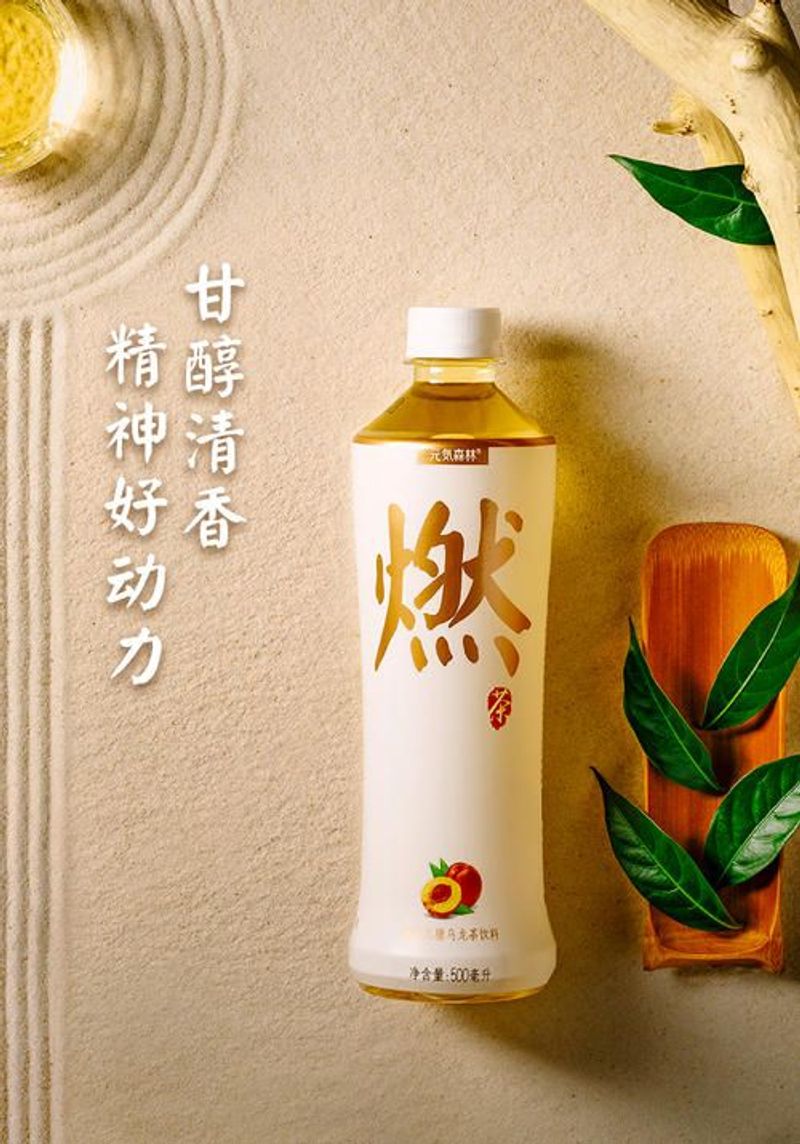
Burning Tea white peach flavor
Another series under the Genki Forest, called “Burning Tea,” has a more wonderful seasoning. It’s like fruit tea made from sugar-free fruit.
When you open a bottle of white peach “burning tea”, a smell of white peach will quickly occupy your nasal cavity. But when you take a sip, you’ll find that the taste doesn’t seem to pass through your mouth. Because “burning tea” uses very little sugar and white peach essence, it attracts you to drink one sip after another through your sense of smell, but all you can feel is the taste of tea.
This sounds incredible. Genki Forest that claims to be a health drink does not use any real fruit, and there are no “natural” raw materials in its drinks other than “tea”. However, it captured a group of young people who were highly sensitive to health.
This is because the brand really understands the definition of “healthy food” in the hearts of young Chinese.
In the view of the older generation, Genki Forest this kind of beverage belongs to the category of “very unhealthy”. In China in the last century, there used to be a name called “Sanjing Water”. “Sanjing Water” or “Three Ingredient Drink”refers to inferior drinks on the market that abuse saccharin, flavor and pigment ingredients without using natural raw materials.
The drinks in Genki Forest just meet the definition of “Sanjing Water”, but the major groups that buy drinks have become younger. Young people in China, on the other hand, have a completely different definition of health.
Different from the popular “purely natural” and “organic” among young people in Europe and the United States, only the elderly people in China admire “purely natural” and “organic”. Young people in China have a more numerical definition of health.
On the one hand, they care about carbohydrates (including sugar), fat and the calories of the food as a whole; on the other hand, they do not care much about whether food is “purely natural” or “synthetic” as long as the “compound” contained in it is legal and safely verified.
In the eyes of young people, Genki Forest is a good substitute for coke and juice, because whether it is the traditional definition of junk food coke or the traditional definition of natural juice of healthy food, it is seen by young Chinese as a calorie bomb containing too much sugar.
See Also: What is Genki Forest?
But the success of Genki Forest was unthinkable a decade ago, because the Chinese beverage industry was colonized in the last decade of the twentieth century and the first decade of the new millennium.
Chinese traditional drink brand
In 1902, 10 years after Coca-Cola was founded, Shanhaiguan Soda was founded in China.
This soda brand is a designated drink for the Qing Dynasty court banquet, serving Emperor Guang Xu’s birthday banquet. And this brand evaded two world wars, going through three regimes: the Qing Dynasty, the Republic of China, and the people’s Republic of China. Even the Communist Party of China’s liquidation movement against the bourgeoisie has not been able to destroy it.
Then it fell in 1986, the early stage of China’s implementation of a market economy.
Don’t be surprised, there are dozens of the same stories in the Chinese beverage industry, behind which there is a common group of killers, multinational beverage companies.
Let’s start with Shanhaiguan and understand this period of history.
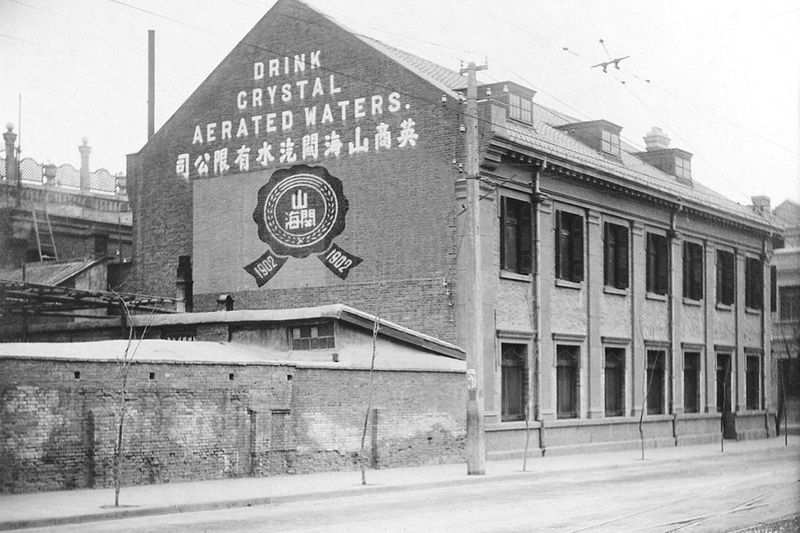
1902, Shanhaiguan soda factory building. credit: Shanhaiguan Official Website
In 1902, British businessman Balin Baldhan established the Universal Mineral Water Company in the British concession in Tianjin. The following year, the company moved to Shanhaiguan area in Hebei Province and changed its name to Shanhaiguan Soda. The company’s English name is Drink Crystal Aerated Waters.
Therefore, strictly speaking, Shanhaiguan soda is not a traditional Chinese brand, but a traditional beverage brand born in China.
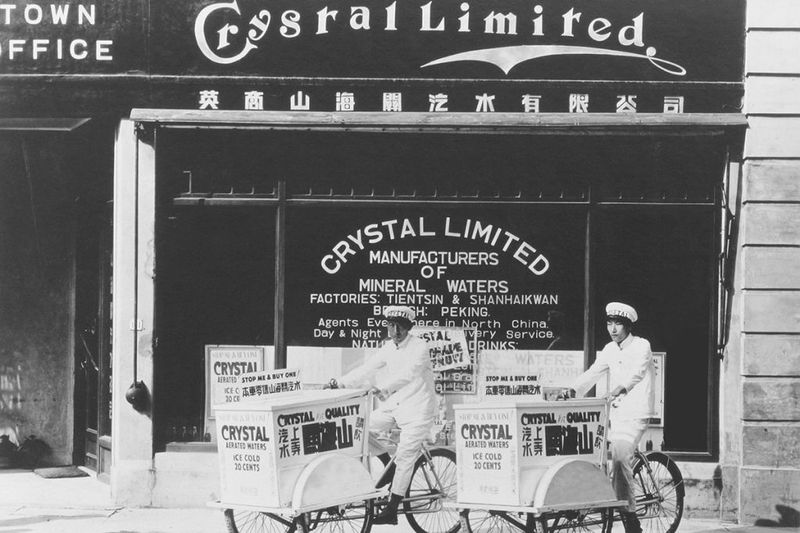
Shanhaiguan selling cars on the streets of Tianjin in the 1930s. credit: Shanhaiguan Official Website
In the early days of Shanhaiguan soda, the company supplied mineral water and other drinks mainly to cities in the North China Plain through a railway network in northern China. Because the product was loved by consumers at China and abroad, Shanhaiguan Soda quickly broke into the high-level social circle of China at that time, and you can even find it in Kissling, the earliest western restaurant in China.
In 1922, Puyi, the last emperor of the Qing Dynasty, held a wedding ceremony in Beijing in the Forbidden City. The banquet gathered all the delicacies that the Qing Dynasty could buy at that time. Shanhaiguan Soda was the only soda brand at the banquet.
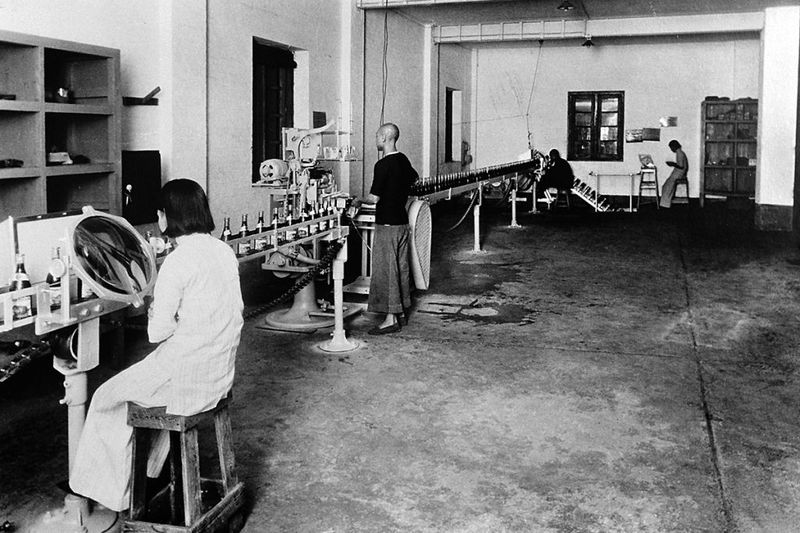
Shanhaiguan production Line in the 1940s. credit: Shanhaiguan Official Website
During World War II, British businessmen lost control of the soda plant and were occupied and destroyed by the Japanese. In 1946, the Chinese began trying to resume production on the ruins of the soda plant.
After the founding of the people’s Republic of China, Shanhaiguan Soda factory became the first state-owned soda enterprise and began to produce classic orange soda.
The soda is packaged like an early Coca-Cola, filled in glass bottles, with a near fluorescent orange and a taste similar to Fanta. Because intellectual property rights in China were often shared at that time, orange soda with similar taste but different brands could be bought in different parts of China at that time. In that era of material scarcity, these sodas formed the common childhood memories of fourth to fifth generations of Chinese.
The peak period of Shanhaiguan soda was the early stage of the reform and opening up of the people’s Republic of China, when China’s economy developed but the private economy has not yet fully risen. Shanhaiguan soda factory met the demand for drinks at that time. At that time, Shanhaiguan Soda expanded its plant, from 12 mu to 100 mu(1 mu =0.0667 hectares), and the output increased from a maximum of 6000 bottles a day to 250 bottles per minute.
At that time, Shanhaiguan soda also tried to innovate in taste, they began to produce bayberry, pineapple, lemon and ginger flavor Shanhaiguan Soda. At the same time, the production of Gavas and salty salt soda has also begun.
By 1986, the annual output value of Shanhaiguan soda exceeded 10 million yuan, which was 20 per cent of the gross domestic product of Tianjin’s light industry in that year.
It is this kind of achievement that has attracted the attention of multinational beverage manufacturers.
That year, Coca-Cola, which returned to the Chinese market for a decade, decided to set up a factory in Tianjin and set up a joint venture with the Shanhaiguan soda plant. According to Wang Jingzhou, then director of Shanhaiguan soda factory, “before the box, Coca-Cola Company also liked the influence of Shanhaiguan as a well-known brand in China.”
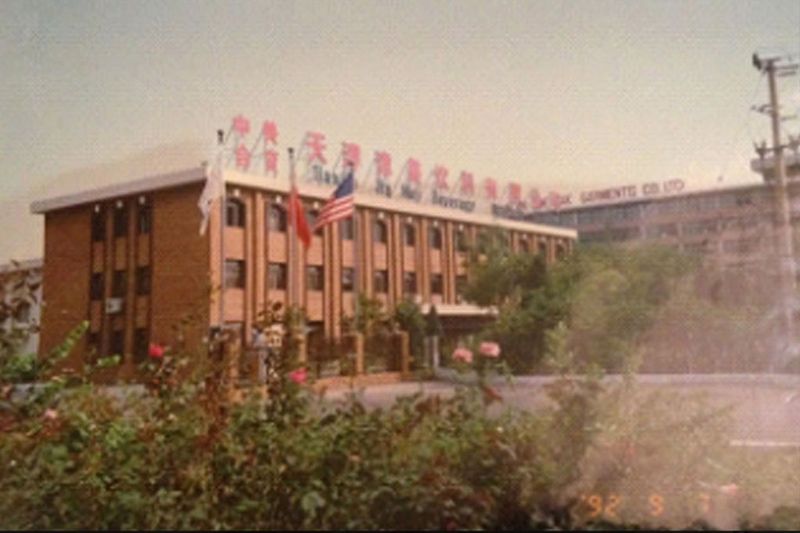
After the merger, Shanhaiguan Company changed its name and raised the national flags of China and the United States in front of the company. credit: Shanhaiguan Official Website
According to records, the negotiation between Shanhaiguan Soda plant and Coca-Cola was not smooth, and the water quality, production scale, market sales capacity and quality control ability of Shanhaiguan Soda plant were questioned for the first time. In order to successfully cooperate with Coca-Cola, Shanhaiguan soda imported water treatment equipment from Romania and redesigned the production line to meet Coca-Cola’s needs.
You are reading Panda!Yoo
A blog about modern Chinese culture and consumption trends. If you are interested in Chinese food, drinks, games, movies, novels, dramas, please follow us.
Join 1,565 other subscribers
However, the development of cooperation is not as good as that envisioned by Shanhaiguan Soda factory, which is not a win-win cooperation. Coca-Cola only uses Shanhaiguan Soda factory as a representative factory and does not give any support for Shanhaiguan Soda brand. Shanhaiguan Soda factory is embarrassed to compete with itself, and Coca-Cola soda produced by them has seized the market of their own brand.
In 1994, eight years after working with Coca-Cola, the Shanhaiguan soda brand disappeared from the market.
The fate of Chinese drink manufacturers: be acquired and shut down
Shanhaiguan soda is not the only Chinese soda manufacturer to be treated like this.
In the stereotyped story, China’s market economy is a “market for technology” scam for foreign companies. But for China’s beverage industry, the story is in the opposite direction.
In the 1980s and 1990s, there were eight large beverage brands in the Chinese market, namely, the Arctic Ocean in Beijing, Zhengguanghe in Shanghai, Shanhaiguan in Tianjin, Bawang Temple in Shenyang, Laoshan Soda in Qingdao, Riverside Soda in Wuhan, Asian Soda in Guangzhou and Tianfu coke in Chongqing.
Surprisingly, almost all of these manufacturers received offers or joint ventures from Coca-Cola or Pepsi in the 1980s or 1990s.
In the history of Beijing Arctic Soda, we can see more clearly how this kind of merger and acquisition suspected of unfair competition is carried out.
The predecessor of Beijing Arctic Ocean was the Beiping Ice Factory, which was founded in 1936. It was renamed Beijing Arctic Ocean in 1950 and registered the iconic Snow Mountain and Polar Bear Logo.
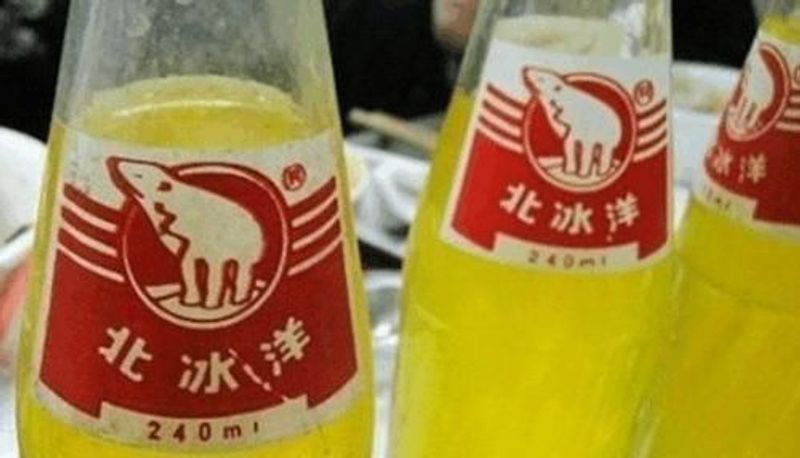
Old Arctic Ocean Soda Logo. credit: CNTV
In 1994, Pepsi took a stake in Arctic Food Co., Ltd., Pepsi Cola began to sell through the Arctic Ocean channel. For the Chinese market in this period, the significance of the sales channel is much greater than the channel itself.
There were not many shopping malls in China, where the market economy is just beginning to be implemented. The main way for people to buy small goods and food is community stores, which are generally run by local residents and do not have a unified supply chain management system.
In the absence of shopping malls and supermarkets, a brand must deal with these community stores ( It is called a “小卖铺”, xiǎo mài bù) one by one if it wants to sell food or drinks to Chinese living in quadrangles courtyard.
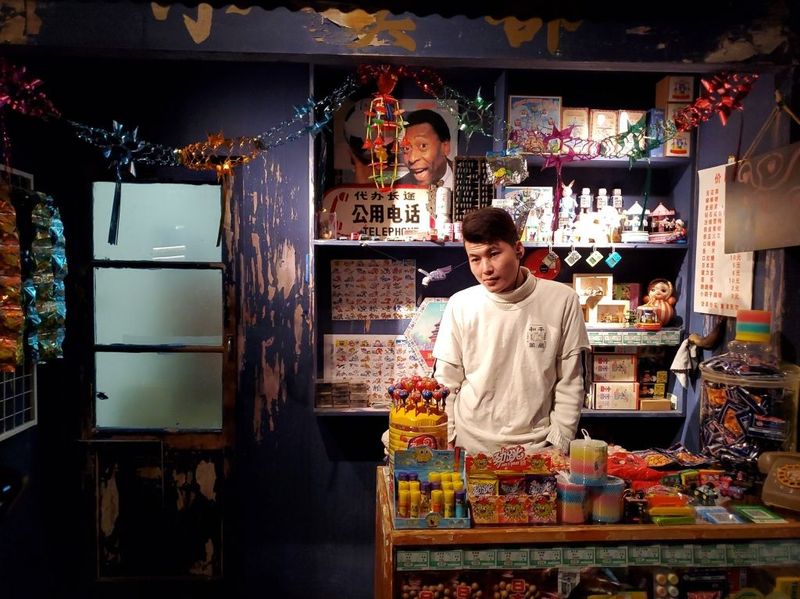
A restored 小卖部 scene in a retro-themed pop-up store in 2019.
The sales channel department of a company must be familiar with the location of these community stores, the living standards and consumption habits of the surrounding residents, and even establish emotional connections with the owners of these stores through logistics personnel-because the owners of these stores not only run stores, but also undertake the work of community salespeople, who recommend their favorite goods and brands to the surrounding residents.
When Pepsi began to sell through Arctic sales channels, it quickly occupied these important resources. Like the embarrassment that Shanhaiguan soda once faced, Arctic soda is caught up in competition with itself.
According to media reports, Pepsi has used Arctic soda sales channels to market anti-Arctic brands, such as providing Pepsi gifts to consumers of Arctic soda, posting posters of Pepsi at outlets in the Arctic Ocean, giving gifts related to the Pepsi brand, and so on.
With several rounds of capital increases, Pepsi has become the substantive controller of the Arctic Ocean in Beijing.
Ma Qian, a 65-year-old skilled worker, joined the Arctic Ocean in Beijing in 1972. After setting up a joint venture with Pepsi in the Arctic Ocean of Beijing, the company’s leaders talked to him and asked him to join Pepsi and promised him a higher salary and a month of overseas holidays a year.
Ma Qian said to the leader: “your energy is all focused on the joint venture, what about the Arctic Ocean itself? If the Arctic Ocean brand disappears. That’s not good. If you have this plan, I’ll quit. “
After that, Ma Qian left the Arctic Ocean in Beijing and opened an equipment factory to produce the equipment needed by the beverage factory.
In 1996, PepsiCo announced the suspension of all Arctic soda Production. (Credit: Rebirth of the Arctic Ocean)
Xing Huiming, a former deputy secretary of the party committee of the company owned by the Arctic Ocean, said: “at that time, everyone said, ‘the moon in foreign countries is more bright than local moonlight,'” said Xing Huiming. “We try to learn management and technology from the West, but we lose our things. “
A similar experience took place in Shenyang Bawang Temple soda.
Founded in 1928, Shenyang Bawang Temple Waterworks was once an important light industry brand of the Republic of China in Northeast China. In addition to the production of soda, the Bawangsi soda factory also produced beer, medical alcohol and other products during the war. On the eve of World War II, Shenyang Bawang Temple soda made Japanese soda manufacturers withdraw from the Chinese market through market competition.
After that, the development path of Bawang Temple soda was roughly the same as that of other Chinese soda brands: according to its official website, “in 1993, a famous American beverage company, by commercial means to help the development of Chinese ethnic drinks and invite a stake, merged the ‘Bawang Temple’ and ‘Jinduo’ trademarks for ten years. In the end, the national brand ‘Bawang Temple’, which has a history of nearly one hundred years, is on the verge of extinction. “
This period of history is called “seriously injured” on the official website of the Bawang Temple soda.
Attacks against established Chinese soda manufacturers are not always the same. Shanghai Zhengguanhe soda factory has been attacked by intellectual property rights.
The English name of Zhengguanghe brand is AQUARIUS, which is used long before the founding of the people’s Republic of China. But until the early 1990s, Zhengwanghe registered only the Chinese word “Zhengwanghe” as a trademark and did not register “AQUARIUS” as its intangible asset.
Coca-Cola took this opportunity to try to preempt “AQUARIUS” as its trademark. if Coca-Cola succeeded, Zhengguanghe had to withdraw all beverages already produced with AQUARIUS Logo.
After many rounds of tug-of-war, Coca-Cola did not succeed, but it significantly consumed Zhengguanhe’s energy.
In 1999, Robust, China’s beverage and drinking water brand, sold 2 billion yuan for the whole year. In 2000, it was controlled by The Danone Group of France and reorganized. Then in 2001, Robust sold 1 billion yuan for the year, well below its former Wahaha. After that, Robust, under the control of Yudaneng Group, cut off the beverage business and kept the drinking water business only. A few years later, the company began to lose money.
Brand
Founded in
Acquirer or partner
Cooperate in
Disappeared or market less than 1% in
Reborn in
Arctic Ocean Soda
1936
Pepsi
1994
1996
2011
Asian soda
1946
Pepsi
1993
1996
2011
Tianfu Coke
1981
Pepsi
1994
2006
2013
Bawang Temple Soda
1920
Coca-Cola
1993
1994
2003
Shanhaiguan Soda
1902
Coca-Cola
1986
1993
2003
Wuhan No.2 Plant soda
1918
Uncertain
–
2000
2017
Robust
1989
Danone
2000
2015
2016
Miaoshi Dairy
1998
Danone
2008
2009
–
Aodeli
1994
Lotte Chilsung
2005
2010
–
Some cases sorted out from Chinese media reports
According to incomplete statistics, at least seven Chinese enterprises were subjected to similar attacks during that period, and in the Chinese business community, the failed battle was known as the “flooding Seventh Army.”
The “Flooding Seventh Army” comes from the Romance of the three kingdoms. Guan Yu used the flood to defeat seven troops at the same time.
Because of the age, it is difficult to find clear evidence that multinational companies have subjective malice in these acquisitions or cooperation. But in the 1990s, China’s social and economic shape was changing dramatically, and joint ventures simply slowed down the pace of reform of these brands or split their existing resources enough to make them disappear.
Back from the dead
2008 was a turning point in the fate of China’s soda industry. On January 1 of that year, the Anti-Monopoly Law of the people’s Republic of China entered into force.
The first and most important case of the bill was the suspension of a multinational merger by China’s Ministry of Commerce under the law: Coca-Cola’s acquisition of Huiyuan Juice.
[sociallocker id=”5614″]
In September 2008, Atlantic Industries, a wholly owned subsidiary of Coca-Cola, offered to buy Huiyuan Juice for HK $12.20 a share, or a total of $17.92 billion HK Dollar, which was twice as high as the share price of Huiyuan juices at the time.
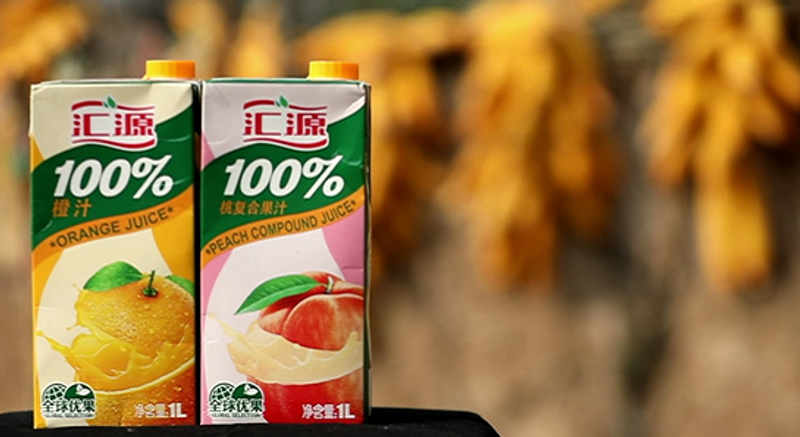
Huiyuan Juice is one of the first brands in China to focus on the pure fruit juice market, and the “100%” on its packaging is the memory of many Chinese for banquets.
Huiyuan Juice is not an international brand, but it is a household name in China. According to the data released by Huiyuan Juice in 2008, the sales of 100% juice and medium concentration fruit and vegetable juice accounted for 43.8% and 42.4% of the total domestic market, respectively.
At that time, Coca-Cola had two fruit juice brands, Meizhiyuan and Qoo, as well as a high market share in China. This means that even if Coca-Cola does not hide Huiyuan after its acquisition of Huiyuan, Coca-Cola will have an absolute monopoly on the juice beverage market.
In 2009, China’s Ministry of Commerce announced that the deal had not passed the review, Coca-Cola did not protest the decision, and told the media that the failure of the acquisition had little impact on the company.
As it is the first official use of the Anti-monopoly Law, this case has attracted the attention of the Chinese and foreign business and legal circles. After denying the acquisition, some chambers of commerce asked the Ministry of Commerce of China to disclose the details of the review of the case in order to help foreign investors determine the legal boundaries of such mergers.
In response, China’s Ministry of Commerce said the case was not the result of China’s use of administrative power to exclude foreign investment, as Huiyuan Juice is also a foreign company under China’s legal framework. In a formal announcement, China’s Ministry of Commerce gave three reasons for denying the acquisition:
- After the completion of the concentration, Coca-Cola has the ability to transmit its dominant position in the carbonated soft drink market to the juice beverage market, which will exclude and limit the competitive effect of the existing juice beverage enterprises, and then damage the legitimate rights and interests of beverage consumers.
- Brand is the key factor affecting the effective competition in the beverage market. After the concentration is completed, Coca-Cola Company will significantly enhance its control over the juice market by controlling the two well-known juice brands “Meijuyuan” and “Huiyuan”. In addition, the existing dominant position in the carbonated beverage market and the corresponding transmission effect will significantly increase the obstacles for potential competitors to enter the juice beverage market.
- It has squeezed the living space of domestic small and medium-sized juice enterprises, restrained the ability of domestic enterprises to participate in competition and independent innovation in the juice beverage market, and has a negative impact on the effective competition pattern of China’s juice beverage market, which is not conducive to the sustainable and healthy development of China’s juice industry.
Regardless of the intention of the Chinese authorities, it has objectively created a space for the resurrection of Chinese beverage enterprises. Since then, the acceptance of foreign investment by Chinese beverage brands has not decreased, but few brands have disappeared as a result of accepting investment.
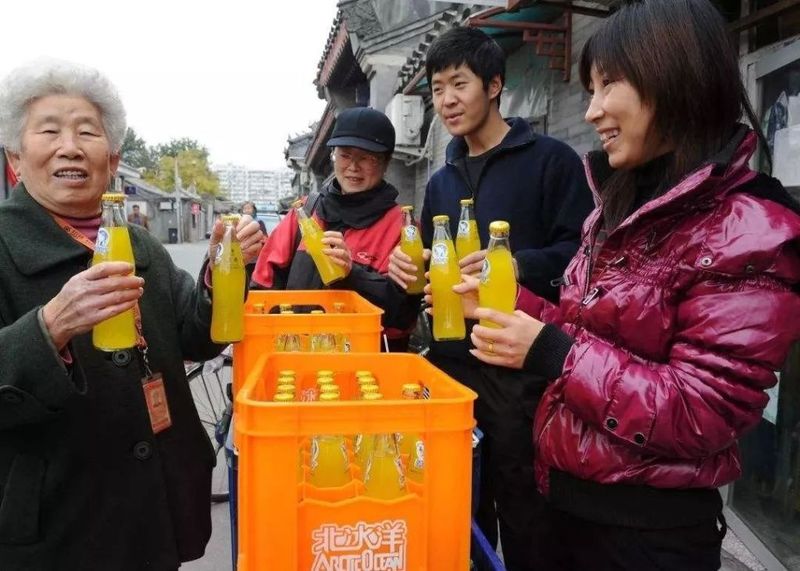
Loyal fans of the Arctic Ocean try the Arctic Ocean after “rebirth” in the cold wind in November 2011. Credit: Luming Finance
In 2007, four years after the complete shutdown of Beijing Arctic soda production, the former owner of the Arctic soda brand, Beijing First Light Chemical Group, negotiated with Pepsi Co. to recover the Arctic Ocean brand.
This process has not been smooth because even within Beijing First Light Chemical Group, there are doubts about the residual value of the brand. After the brand was recycled, the Arctic Ocean brand was also banned from soda production until 2011, according to previous agreements.
But in the end, Arctic soda was officially revived in November 2011 and began offering trial versions in some designated merchants. Two months after it went public, Arctic soda began to turn a profit. For the whole of 2012, Arctic soda sold 1 million cases, with sales exceeding 60 million. Sales exceeded 100 million yuan in 2014, and “Arctic soda” began to fall short of demand.
The resurrection of Arctic soda is not as simple as pressing the restart button on a fully automatic assembly line because of a long halt to sales and multiple resale of related assets.
Staffs have traveled across China to find suppliers who once supplied Arctic soda. The loss of many important materials made it difficult to master the accurate original recipe, and the staff organized many former loyal fans of Arctic soda to try to make the newly produced soda have a “nostalgic flavor.”
The increase in sales is not due to the cheap “Arctic soda”. On the contrary, the culturally meaningful drink for Chinese in the north is priced at a much more expensive price than coke at the moment.
The resurrection of the Arctic Ocean is lucky, but it is only a sign. Returning to business logic, the Arctic Ocean is no longer a drink but a cultural product to some extent. Although it has good sales for itself, it is inconspicuous in the Chinese beverage market.
The real significance of the resurrection of the Arctic Ocean is that with the improvement of Chinese law and the growth of China’s economy, China’s beverage market has once again opened to local enterprises. The “Genki Forest” mentioned at the beginning of this article is one of them.
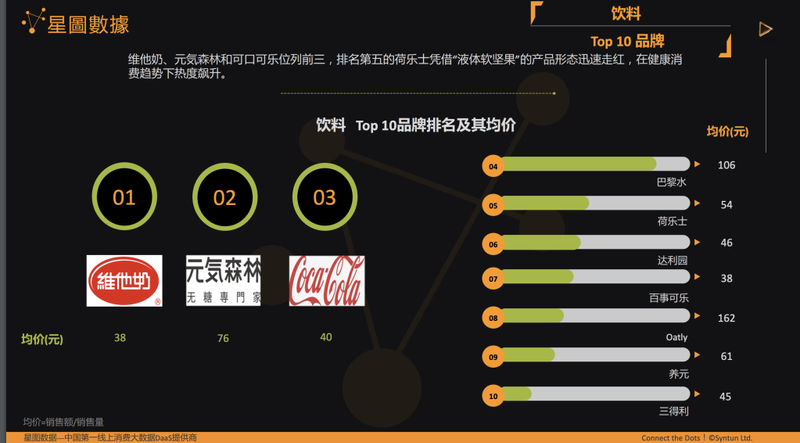
the double 11 beverage sales ranking and the average unit price of each brand. credit: Syntun
In 2019, the Single’s Day beverage sales ranking and the average unit price of each brand, the first Vitasoy, second is Genki Forest, the third is Coca-Cola, the fourth is Paris Water, the fifth is Holox, the sixth is DaliYuan, the seventh is Pepsi, the eighth is Oatly, the ninth is Yangyuan, and the tenth is Suntory.
On the list, Vitasoy, Honie’s, and Dali Group and Yangyuan Group are Chinese brands.
Among them, Vitasoy from Hong Kong, China, achieved the best sales, but it did not come from the stereotyped soy milk products, but from another 20-year-old drink under its brand, VITA LEMON TEA.
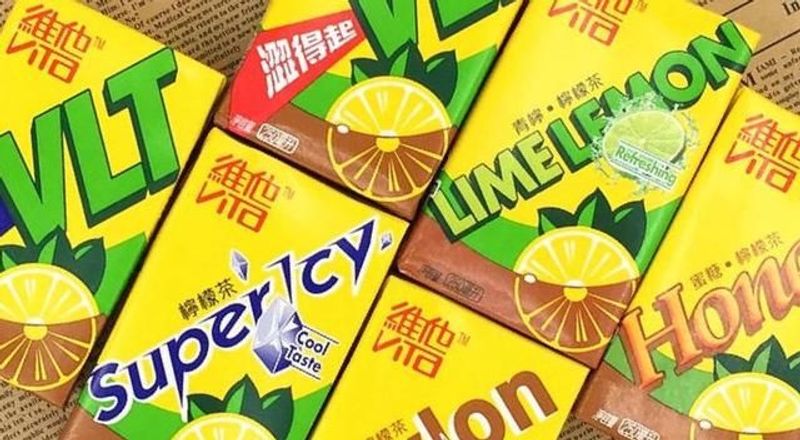
vita lemon tea
The manufacturer succeeded in turning frozen lemon tea into packaged drinks. Frozen lemon tea, a local drink, is often used in Hong Kong teahouses to eat with dinner. It is a very cool drink on the taste and can effectively solve the residual taste of food in the mouth after eating.
Vita Lemon Tea was originally only popular in southern China because of the habit of drinking Frozen lemon tea in those areas. But in 2016, with the popularity of an online meme, “维他柠檬茶,爽过吸大麻” (“wéi tā níng méng chá, shuǎng guò xī dà má”, Meaning: drinking lemon tea is more pleasure than smoking cannabis) became popular on the Chinese Internet, Vita lemon tea quickly opened up the market throughout mainland China.
Memes about Vita Lemon Tea made by some netizens
By 2019, the “Lemon tea+Cannabis” combination had 190000 search results on Chinese search engines. Because of the popularity of this meme, many people think it accurately describes the taste of Vita lemon tea: you can’t say how good the drink is, but once you’ve tried it and don’t drink it for a while, you’ll miss it very much, like a withdrawal reaction.
Although Vita Lemon Tea has a sugar content of nearly 13 per cent, it strike a perfect balance between the sweetness of sugar, the bitterness of tea and the sour taste of lemons. When you take a sip of Vita Lemon Tea, the first thing you feel is the sweetness of your mouth, but since the citric acid neutralization does not make people feel sticky, the taste will turn into a bitter taste with a unique flavor of tea, which will make your tongue feel a little uncomfortable, so that you begin to look forward to taking another sip of Vita Lemon Tea.
Of course, Vita Lemon Tea definitely doesn’t contain any drugs. In order to meet the demand for health, Vita Lemon Tea has also introduced sugar-free and semi-sugar versions.
Another local brand worth mentioning is Yangyuan Group, which has a better-known name “Six Walnuts” in the hearts of Chinese consumers.
Yangyuan Group used to be a company on the verge of bankruptcy until they launched “Six Walnuts” in 2005.
“Six Walnuts” may be one of the only drinks that parents will encourage in China, contrary to Genki Forest, which is fully in line with the health concepts of the middle-aged and the elderly and affects students by selling them to parents.
“Six Walnuts” is not the only plant protein drink on the market. It used to have “Yeshu coconut juice” and “Lulu almond dew” in the Chinese market, but Chinese middle-aged and elderly consumers have a unique love of walnuts.
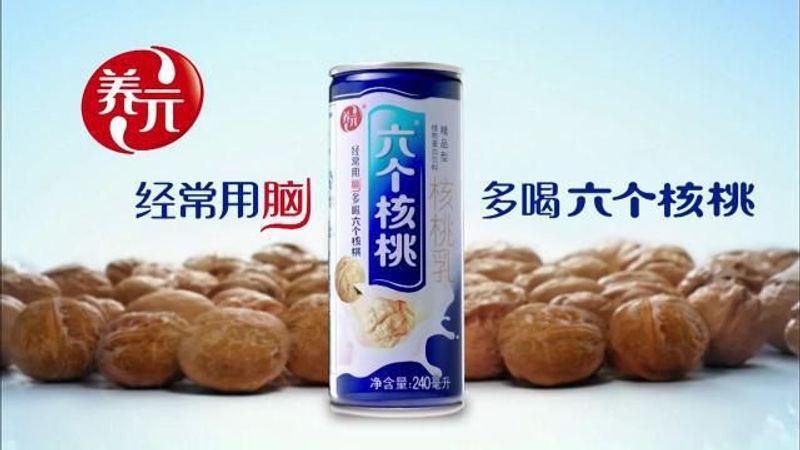
“Six Walnuts” is a plant protein drink that contains at least six walnuts (but not confirmed by a third party) in each can of it.
In the field of traditional Chinese medicine, walnuts are thought to replenish the brain because their nuts are similar in shape to the brain. According to the report, the per capita daily nut intake of the Chinese is well below the recommended level, with the exception of walnuts. The slogan “Six Walnuts” reinforces this recognition: if you use the brain frequently, you should drink more “Six Walnuts.”
In 2008, there was an appalling “melamine incident” in China’s dairy industry. Many Chinese families stop buying milk. Yangyuan Group took the opportunity to carry out a lot of marketing, making the “Six Walnuts” to some extent a substitute for milk.
However, because the brand did not meet the requirements of the old Trademark Law for a long time. (A sign that does not have a distinctive characteristic)
As a result, there are many fake brands similar to “Six Walnuts” on the market. It was only in 2015 that, Yangyuan Group successfully registered “Six Walnuts” as a trademark. If you want to try “Six Walnuts,” it’s best not only to identify the “Six Walnuts” Logo, but also to see if its manufacturer is Yangyuan Group.
Overall, local beverage companies in China are growing rapidly and have an impact on Coca-Cola and Pepsi. No, not actually.
According to the data, both Coca-Cola and Pepsi still have very high sales in China, with two of Coca-Cola’s Chinese subsidiaries (Swire Pacific Limited and China Foods Limited) generating 37.3 billion yuan in revenue in 2018. In terms of market share, Paris Water, Honice’s, Oatly, Suntory and other foreign brands have also rapidly expanded sales in China.
Although we use anti-colonialism to describe the war, in fact it has gradually moved towards a win-win outcome, avoiding the destruction of Chinese beverage companies by foreign capital and enriching the market landscape. On the other hand, the overall growth of China’s soft drink consumer market makes any positioning of brands and drinks have room for development.
[/sociallocker]
- Author:NotionNext
- URL:https://pandayoo.com/2020/02/26/the-de-colonization-of-chinese-drink
- Copyright:All articles in this blog, except for special statements, adopt BY-NC-SA agreement. Please indicate the source!